L’IDEA
Almeno tre anni fa sul web mi imbattei in una foto, un fante
giapponese scalzo con in spalla un moschetto automatico tipo 100 con alle
spalle un elefante : subito nacque il desiderio di farne un diorama.
In tutta l’Asia e in special modo in Birmania gli elefanti
sono stati e sono ancora oggi (soprattutto nell’industria del legname)
utilizzati come bestie da soma ideali per l’attraversamento di zone
particolarmente impervie e di foreste.
Durante la guerra del Vietnam, gli artiglieri distaccati ai
reparti di marines o fanteria nella giungla avevano l’ordine di dirigere il
fuoco sui branchi di elefanti che erano classificati come mezzi di trasporto
nemici, visto che i Vietcong li utilizzavano per il trasporto di armi, viveri e
simili (Matterhorn di K.Marlantes).
In Birmania, i Giapponesi li utilizzarono sin da subito sia
per le perlustrazioni di zone poco accessibili ( Japanese Monograph n° 104) sia
per il trasporto di vettovagliamenti.
Durante la disastrosa operazione Imphal ( per i Giapponesi U-GO)
vennero impiegati 1030 elefanti ( Tales by japanese soldiers di Nunneley e
Tamayama) che, a differenza di buoi, muli e cavalli, sopravvissero quasi tutti.
GLI ELEFANTI
Ho iniziato un poco alla volta a raccogliere il materiale e
le informazioni e alla fine ho cominciato a dar vita a questo diorama che mi ha
richiesto circa quattro mesi di lavoro.
Gli elefanti sono dei bellissimi pezzi della Schleich (referenze 2514653 e 2514654) ai quali ho
modificato la coda con Magic Sculpt e che ho ricolorato con un lavaggio grigio
topo acrilico ottenuto con bianco e nero Italeri, seguito da un altro lavaggio con pittura ad
olio Maimeri Terra di Kassel e per
finire un dry brush con olio W&N ocra gialla.
L’imbottitura su cui doveva poggiare la struttura lignea è
stata ricavata da terracotta e Magic Sculpt poi dipinta in marrone acrilico e
terminata con dry brush colori ad olio W&N bianco, ocra e lavaggio Van
Dyck.
La struttura lignea, ricostruita a partire da una delle rare
foto dell’epoca e da alcune recenti è
composta da legno per modellismo navale fornito da Amati Modellismo (come anche
tutti i colori Vallejo Air), successivamente dipinto con lavaggi ad olio Siena,
ombra naturale e terra di kassel seguiti da dry brush bianco, giallo napoli e
carnicino.
Sul secondo elefante, ho inserito nella struttura lignea il
kit delle casse di munizioni della Amati per fare volume e con un fazzolettino
imbevuto di colla vinilica ho ricreato il telo.
I FIGURINI
I conducenti di elefanti sono un mix di “avanzi” di vari kit
sistemati e abbigliati con una mescola di Magic Sculpt e green stuff.
Le teste sono Hornet
e i piedi Historex; la trama dei berretti di paglia è stata ricreata
schiacciando lo stucco su un tulle da bomboniere.
I due figurini sul primo elefante sono un Mini Art 35138 (con
lievi modifiche e testa Hornet) e un Fine Molds FM 38 (anche questo con qualche
modifica).
Molti criticano i Fine Molds per le dimensioni, ma
sono gli unici realmente in scala, visto che i giapponesi di quel periodo erano
alti meno di un metro e sessanta.
L’ufficiale a cavallo è un mix di referenze Mini Art 35138 e
Dragon 6410; la coda e la criniera del cavallo sono state ricreate
con Magic Sculpt; i fanti a piedi sono tutti Fine Molds FM 37 con lievi modifiche.
Da sottolineare le
reti degli elmetti ricavate da tulle per bomboniere e la presenza di armi di
preda bellica.
I giapponesi avevano
8 tipi di munizionamento differente per le armi da fuoco, cosa che creava gravi
problemi logistici, quindi spessissimo utilizzavano un vasto numero di armi di
preda bellica (Le armi della fanteria giapponese nella seconda guerra mondiale
di G.Markham).
Durante l’operazione
Imphal la scarsità di armi e munizioni portò l’alto comando a prescrivere, come
di primaria importanza, la cattura del più alto numero possibile di armi
nemiche (Japanese Monograph n° 104 e Tales by japanese soldiers di Nunneley e
Tamayama).
Il moschetto automatico Tipo 100 del figurino vicino al
primo elefante è stata ricavato modificando una Bergman Dragon; gli occhiali
del figurino sono una fotoincisione Alliance.
I piedi di tutti i figurini sono Historex mentre le scarpe
sono state ricavate da quelle originali dei figurini.
Il telino per l’elmetto, la barba e i teli copri nuca sono
stati creati con stucchi bi componente.
Per i colori delle uniformi è stato di vitale importanza il
magnifico volume Heitai di A.Sàiz,
ricco di documentazione fotografica su tutto
l’equipaggiamento.
In azione i
giapponesi non portavano nè distintivi nè spalline, al massimo delle mostrine
da tasca o da colletto e spesso nemmeno quelle.
Tutte quelle che ho
utilizzato sono decal presenti nel kit Fine Molds.
Le uniformi bianche ho rappresentato sono le uniformi da
fatica usate per non rovinare quelle da combattimento; i pantaloni, di differenti
varietà di color kaki, erano nei classici tessuti che stingevano per la scarsa
qualità del colore.
Tutti i figurini sono stati dipinti con acrilici, Vallejo
Air e Life Color e poi finiti con pitture ad olio Maimeri e W&N.
Per il colore di base della giacca ho usato Vallejo Air
71055 mescolato all’71004 , per gli incarnati 71079 +71040+71075 e per i
berretti e i pantaloni colore di base Vallejo 71075; la finitura ad olio ha
dato le differenti sfumature di colore.
BASE E VEGETAZIONE
Per la base ho usato un porta fotografie 30x40 cm, la
morfologia del terreno è stata data con terracotta, polistirolo e cartone; per
il terreno ho usato colla per mattonelle
su cui ho versato terre da colorificio.
Per riprodurre il bamboo ho utilizzato cannucce dell’Estathe
, ho carteggiato la parte lucida e vi ho legato del filo per ricreare le
nodosità della crescita.
Ho poi messo sui fili colla vinilica per inspessire un pò,
quindi ho dipinto ad aerografo con Vallejo Air 71075 e poi con 71116 mescolato
con due gocce di trasparente lucido; per finire lavaggio ad olio ombra
naturale.
Rami ottenuti con Teloxis Aristata e le foglie con carta velina
dipinta fronte e retro (avevo previamente preparato due fogli, il primo dipinto
con Vallejo Air 013 e 7195 e l’altro con 71006 e 012).
Le mangrovie sono state riprodotte usando Teloxis Aristata e
origano, le foglie della piccola palma sono
di carta velina e così anche le grandi
foglie tropicali.
Le felci sono rami di mimosa trattate con colla vinilica e
con dei rami di origano ho tentato di ricreare delle piante di luppolo
tropicale.
Volendo ricreare l’avvicinamento a un guado o, comunque, una
zona con dell’acqua, appena presente ma abbastanza da giustificare i piedi
scalzi della truppa, ho previamente
trattato il fondo con colla vinilica diluita
su cui ho usato la Still Water
THE IDEA
At least three years ago I saw a photo on the web, an infantryman Japanese barefoot and shouldered an automatic rifle type 100 with behind an elephant immediately was born the desire to make a diorama.
Throughout Asia and especially in Burma elephants were and still are (especially in the timber industry) used as beasts of burden ideal for crossing of particularly inaccessible areas and forests.
During the Vietnam War, marines and infantry units in the jungle had orders to direct artillery fire on the herds of elephants that were classified as enemies means transport, the Vietcong used them to transport weapons, provisions and similar (Matterhorn K.Marlantes).
In Burma, the Japanese used them right away and for the patrols of distant areas (Japanese Monograph No. 104) is for transporting provisioning.
During the disastrous operation Imphal (for the Japanese U-GO) were employed i 1030 elephants (Tales by japanese soldiers of Nunneley and Tamayama) that, unlike oxen, mules and horses, survived almost everyone.
THE ELEPHANTS
I started a little at a time to collect the material and information, and at the end I began to forge this diorama took me about four months of work.
Elephants are beautiful pieces of Schleich (2514653 and 2514654 references) to which I modified the tail with Magic Sculpt and I recolored with a gray acrylic wash mice obtained with black and white Italeri, followed by another wash to Maimeri oil painting land of Kassel and finally a dry brush with W & N ocher yellow oil.
The padding on which was to place the wooden structure was made from terracotta and Magic Sculpt then painted in brown acrylic and finished with dry brush oil colors W & N white, ocher and washing Van Dyck.
The wooden structure was rebuilt from a rare period photos and some recent and consists of wooden for ship models provided by Amati Model (as well as all Vallejo Air Color), then painted with washes oil Siena, natural shade and the land of Kassel followed by dry brush white, yellow flesh and napoli.
The second elephant, I plugged in the wooden structure of the Amati ammunition boxes kit cover with clinex soaked with vinyl glue for recreated the tarpaulin.
THE FIGURES
The mahouts are a mix of "leftovers" of various accommodated kit and dressed in a mix of Magic Sculpt and green stuff.
The heads are Hornet and the feet Historex ; the texture of straw hats was recreated by squeezing the grout on a tulle .
The two figures on the first elephant is a Mini Art 35138 (with slight modifications and head Hornet) and Fine Molds FM 38 (also with some modifications).
Many criticize the Fine Molds for the size, but they are really unique in scale, given that the Japanese of that era were high less than one meter and sixty.
The officer on horseback is a mix of references Mini Art 35138 Dragon and 6410; the tail and the mane of the horse have been recreated with Magic Sculpt; the infantry on foot are all Fine Molds FM 37 with slight modifications.
To did the net of helmets i use tulle for wedding favors and the presence of weapons of war booty.
The Japanese had 8 different types of ammunition for firearms, which created serious logistical problems, so often used a large number of war booty weapons (Weapons of Japanese infantry in World War G.Markham).
During the operation Imphal shortage of arms and ammunition he brought the high command to prescribe, as of primary importance, the capture of the highest possible number of enemy weapons (Japanese Monograph No. 104 and Tales by japanese soldiers of Nunneley and Tamayama) .
The automatic rifle of the type 100 appear next to the first elephant was obtained by modifying a Bergman Dragon; the glasses appear are a gravure Alliance.
The feet of all the figures are Historex while shoes have been converted from the original sketches of those.
The drape for a helmet, beard and the neckcurtain towels were created with bi component stucco.
For the colors of the uniforms was vital the magnificent volume of Heitai A.Sàiz,
rich photographic documentation of all equipment.
In action the Japanese did not wear nor distinctive nor straps, to the best of trims pocket or collar, and often not even those.
All the ones I've used are present in the decal Fine Molds kit.
I represented white uniforms are the uniforms used hard not to ruin the fighter; pants, different variety of khaki, were in classic fabrics that stingevano for the poor color quality.
All figures have been painted with acrylics, Vallejo Air and Life Color and then finished with a Maimeri oil paintings and W & N.
For the base color of the jacket I used Vallejo Air 71055 mixed all'71004, for incarnate 71079 + 71040 + 71075 and the caps and the basic color pants Vallejo 71075; The oil finish has given the different shades of color
BASE AND VEGETATION
For the base I used a 30x40 cm photographs frame, the morphology of the land was given with clay, polystyrene and cardboard; for the ground I used glue for tiles on which I poured pigment.
I used to do the bamboo the straws dell'Estathe, I sanded the shiny side and I tied the wire there to recreate the knotty growth.
I then put on glue wires to thicken a little, so I painted airbrushed with Vallejo Air 71075 with 71116 and then mixed with two drops of clear gloss; to finish i washing with oil natural shade.
Branches was obtained with Teloxis Aristata and leaves with tissue paper painted front and back (I had previously prepared two sheets, the first painted with Vallejo Air 013 and 7195 and the other with 71 006 and 012).
Mangroves have been reproduced using Teloxis Aristata and oregano, leaves of palm are small tissue paper and so are the large tropical leaves.
The ferns are mimosa branches treated with glue and with the branches of Oregano I tried to recreate the tropical hop plants.
Wanting to recreate the approach to a ford, or at least an area with water, just present but enough to warrant bare foot troop, I have previously treated the bottom with vinylic glue diluted on which I used Vallejo Still Water.

THE IDEA
At least three years ago I saw a photo on the web, an infantryman Japanese barefoot and shouldered an automatic rifle type 100 with behind an elephant immediately was born the desire to make a diorama.
Throughout Asia and especially in Burma elephants were and still are (especially in the timber industry) used as beasts of burden ideal for crossing of particularly inaccessible areas and forests.
During the Vietnam War, marines and infantry units in the jungle had orders to direct artillery fire on the herds of elephants that were classified as enemies means transport, the Vietcong used them to transport weapons, provisions and similar (Matterhorn K.Marlantes).
In Burma, the Japanese used them right away and for the patrols of distant areas (Japanese Monograph No. 104) is for transporting provisioning.
During the disastrous operation Imphal (for the Japanese U-GO) were employed i 1030 elephants (Tales by japanese soldiers of Nunneley and Tamayama) that, unlike oxen, mules and horses, survived almost everyone.
THE ELEPHANTS
I started a little at a time to collect the material and information, and at the end I began to forge this diorama took me about four months of work.
Elephants are beautiful pieces of Schleich (2514653 and 2514654 references) to which I modified the tail with Magic Sculpt and I recolored with a gray acrylic wash mice obtained with black and white Italeri, followed by another wash to Maimeri oil painting land of Kassel and finally a dry brush with W & N ocher yellow oil.
The padding on which was to place the wooden structure was made from terracotta and Magic Sculpt then painted in brown acrylic and finished with dry brush oil colors W & N white, ocher and washing Van Dyck.
The wooden structure was rebuilt from a rare period photos and some recent and consists of wooden for ship models provided by Amati Model (as well as all Vallejo Air Color), then painted with washes oil Siena, natural shade and the land of Kassel followed by dry brush white, yellow flesh and napoli.
The second elephant, I plugged in the wooden structure of the Amati ammunition boxes kit cover with clinex soaked with vinyl glue for recreated the tarpaulin.
THE FIGURES
The mahouts are a mix of "leftovers" of various accommodated kit and dressed in a mix of Magic Sculpt and green stuff.
The heads are Hornet and the feet Historex ; the texture of straw hats was recreated by squeezing the grout on a tulle .
The two figures on the first elephant is a Mini Art 35138 (with slight modifications and head Hornet) and Fine Molds FM 38 (also with some modifications).
Many criticize the Fine Molds for the size, but they are really unique in scale, given that the Japanese of that era were high less than one meter and sixty.
The officer on horseback is a mix of references Mini Art 35138 Dragon and 6410; the tail and the mane of the horse have been recreated with Magic Sculpt; the infantry on foot are all Fine Molds FM 37 with slight modifications.
To did the net of helmets i use tulle for wedding favors and the presence of weapons of war booty.
The Japanese had 8 different types of ammunition for firearms, which created serious logistical problems, so often used a large number of war booty weapons (Weapons of Japanese infantry in World War G.Markham).
During the operation Imphal shortage of arms and ammunition he brought the high command to prescribe, as of primary importance, the capture of the highest possible number of enemy weapons (Japanese Monograph No. 104 and Tales by japanese soldiers of Nunneley and Tamayama) .
The automatic rifle of the type 100 appear next to the first elephant was obtained by modifying a Bergman Dragon; the glasses appear are a gravure Alliance.
The feet of all the figures are Historex while shoes have been converted from the original sketches of those.
The drape for a helmet, beard and the neckcurtain towels were created with bi component stucco.
For the colors of the uniforms was vital the magnificent volume of Heitai A.Sàiz,
rich photographic documentation of all equipment.
In action the Japanese did not wear nor distinctive nor straps, to the best of trims pocket or collar, and often not even those.
All the ones I've used are present in the decal Fine Molds kit.
I represented white uniforms are the uniforms used hard not to ruin the fighter; pants, different variety of khaki, were in classic fabrics that stingevano for the poor color quality.
All figures have been painted with acrylics, Vallejo Air and Life Color and then finished with a Maimeri oil paintings and W & N.
For the base color of the jacket I used Vallejo Air 71055 mixed all'71004, for incarnate 71079 + 71040 + 71075 and the caps and the basic color pants Vallejo 71075; The oil finish has given the different shades of color
BASE AND VEGETATION
For the base I used a 30x40 cm photographs frame, the morphology of the land was given with clay, polystyrene and cardboard; for the ground I used glue for tiles on which I poured pigment.
I used to do the bamboo the straws dell'Estathe, I sanded the shiny side and I tied the wire there to recreate the knotty growth.
I then put on glue wires to thicken a little, so I painted airbrushed with Vallejo Air 71075 with 71116 and then mixed with two drops of clear gloss; to finish i washing with oil natural shade.
Branches was obtained with Teloxis Aristata and leaves with tissue paper painted front and back (I had previously prepared two sheets, the first painted with Vallejo Air 013 and 7195 and the other with 71 006 and 012).
Mangroves have been reproduced using Teloxis Aristata and oregano, leaves of palm are small tissue paper and so are the large tropical leaves.
The ferns are mimosa branches treated with glue and with the branches of Oregano I tried to recreate the tropical hop plants.
Wanting to recreate the approach to a ford, or at least an area with water, just present but enough to warrant bare foot troop, I have previously treated the bottom with vinylic glue diluted on which I used Vallejo Still Water.




















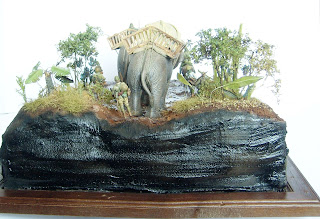








































































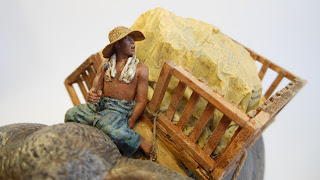









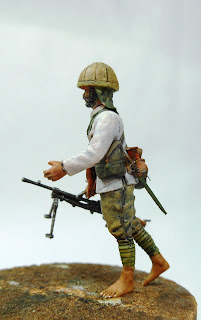




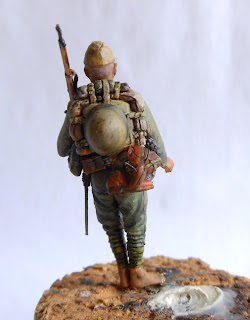




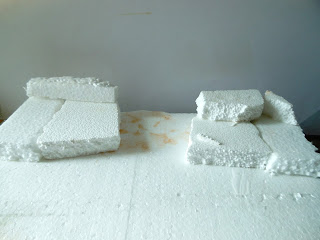































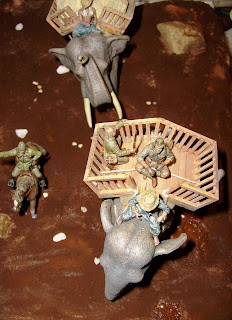


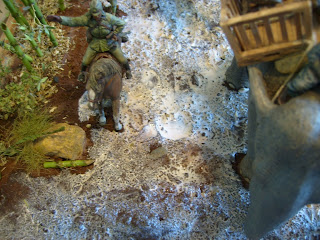



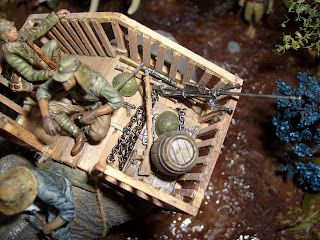
Nessun commento:
Posta un commento